Introduction
You’d be forgiven to think that ChatGPT has been around for years with how much people go on about it. ChatGPT is actually new — it launched back in November 2022. Since then, it’s been the major talking point, and people keep discussing how AI chatbots (and AI in general) will impact our lives.
ChatGPT’s meteoric rise made it the fastest-growing consumer app in history. While the majority of users still use it as a plaything, many SMBs have included ChatGPT in their business model. With the app, you can save on costs, automate tasks, generate marketing material, and improve your customer experience.
In this article, we’ll go over some of the most interesting facts about ChatGPT, its alternatives, and how it can impact your business. We’ll also show you how our software can help you set up your AI startup faster with our AI-powered name generator that will create 1,000+ memorable name ideas in an instant.
A Brief History of ChatGPT’s Brief History
Prior to launching ChatGPT in November 2022, OpenAI had worked on developing the app since 2018. During the early development phase, OpenAI focused on language understanding, with the first instance of the app, GPT-1, using only 5 GB of data points.
In June 2020, they launched GPT-3, a much more comprehensive model that was a cornerstone for multiple apps:
- ChatGPT
- Whisper (transcribes voice to text)
- DALL-E (uses text to generate images)
- CLIP (connects images and text)
GPT-3 (and its successor GPT-4) relies on human feedback to keep improving and developing its model. In 2020, OpenAI spent $12 million on a single training run to get user feedback. If you’re wondering why ChatGPT is free, you should read between the lines here.
Today, ChatGPT is one of the most talked-about apps worldwide, bringing 100 million active users in January 2023 alone.
Key findings
Here are some key findings about ChatGPT:
- Launched: November 2022
- Created by: OpenAI
- Website visits: 1 billion
- ChatGPT daily users: 25 million
- Queries per day: 10 million
- Model size: 570 GB
- Knowledge base: Up to 2021
- Estimated revenue (2023): $200 million
- Estimated revenue (2024) $1 billion
What Is ChatGPT?
ChatGPT is a natural language processing tool that uses AI technology to provide answers to queries while mimicking a normal conversation. You can use the app to find facts, automate processes, and generate content or code.
A chatbot, in general, is software that simulates human-like conversations via chat. They are most often encountered in customer service. As a business, you can use chatbots to reduce the need for human interaction as the software can answer some of the most frequent consumer queries that have straightforward answers.
However, most customer service chatbots don’t have incredibly advanced AI models that can independently interact with users and often resort to being a middleman between customers and a support rep. As of 2022, only a minority of U.S. customers said they were happy with chatbot customer service.
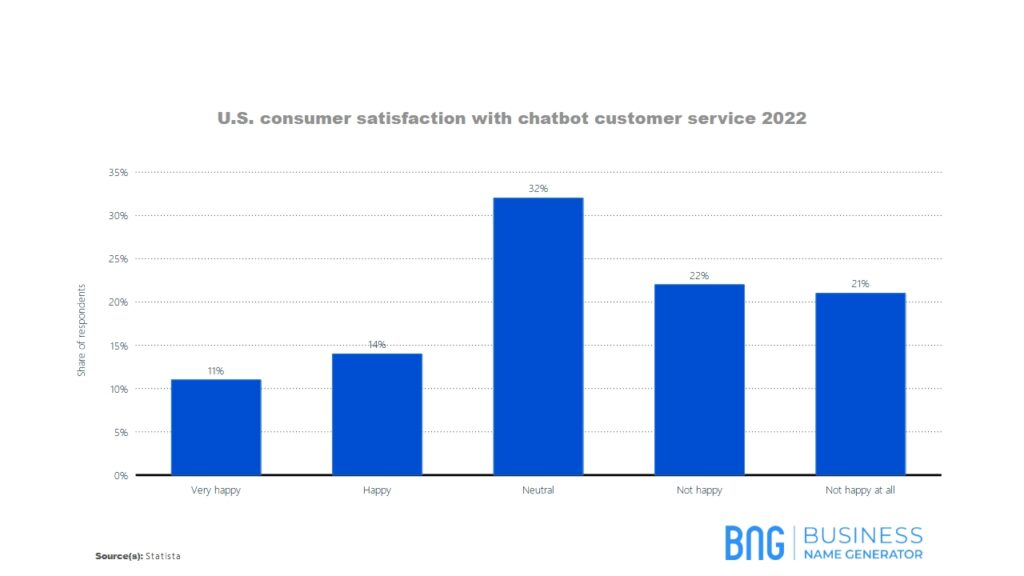
Now, AI and chatbots have been around for decades. The first popular chatbot was ELIZA, developed in 1966. So, what makes ChatGPT so outstanding and revolutionary?
The answer is — GPT-3. It’s the largest language model ever made, with 175 billion parameters at its disposal.
Another aspect of GPT-3 that makes it superior is the fact that it’s an autoregressive language model. This means that, while generating text, it analyzes the words it uses to predict what would be the most fitting word that follows. This makes ChatGPT’s answers eerily human-like, with the majority of us not being able to discern between human-written and ChatGPT-generated articles.
What Was the Size of the Dataset Used to Train ChatGPT?
ChatGPT has been in development since 2018. It started with GPT-1 and grew continually. In March 2023, it switched to its latest model, GPT-4. With each upgrade, the developing team increased the size of the dataset that the AI model had available.
| Model Version | Number of Parameters | Dataset Size |
|---|---|---|
| GPT-1 | 120 million | 5 GB |
| GPT-2 | 1.5 billion | 40 GB |
| GPT-3 | 175 billion | 570 GB |
| GPT-4 | 100 trillion | Unknown |
GPT-3’s size of 570 GB meant that ChatGPT was trained on a dataset of around 175 billion parameters and over 300 billion words.
The latest version, GPT-4, has almost 100 trillion parameters, equaling the human brain’s capacity. While we don’t know the size of the GPT-4 dataset, many believe it’s actually close to the GPT-3 size. This makes it more optimized, quicker, and efficient.
For example, the ChatGPT character limit was 4,096, which roughly translates to about 500 words. With GPT-4, the app will be able to process and generate up to 25,000 words, allowing it to make long-form content and document analysis.
The GPT-4 working memory is also greater. The software remembers up to 64,000 words (about 50 pages), which makes it able to refer to earlier points of the conversation.
Where does ChatGPT get its data?
ChatGPT uses a large body of text to form its data set. As the largest language model to dat, it contains much more data than a single human brain can hold. While the app doesn’t have access to the internet, the model used online sources to train the chatbot. It sources information from Wikipedia, books, research articles, scientific journals, and websites.
ChatGPT Statistics — Overview
One of the most fascinating aspects of ChatGPT is how quickly it’s risen to be one of the most recognizable brands in the world. OpenAI may have been positive about the impact of its app on the AI industry, but surely not even the most optimistic among them expected such a success.
According to Statista, ChatGPT is by far the most successful online service in terms of reaching the first million users:
| Service | Time to Reach a Million Users |
|---|---|
| ChatGPT | 5 days |
| 2.5 months | |
| Spotify | 5 months |
| Dropbox | 7 months |
| 10 months | |
| Foursquare | 13 months |
| 2 years | |
| Airbnb | 2.5 years |
| Kickstarter | 2.5 years |
| Netflix | 3.5 years |
The interest in ChatGPT didn’t wither — except for a slight dip around Christmas, the number of search queries regarding the app was on a constant rise.
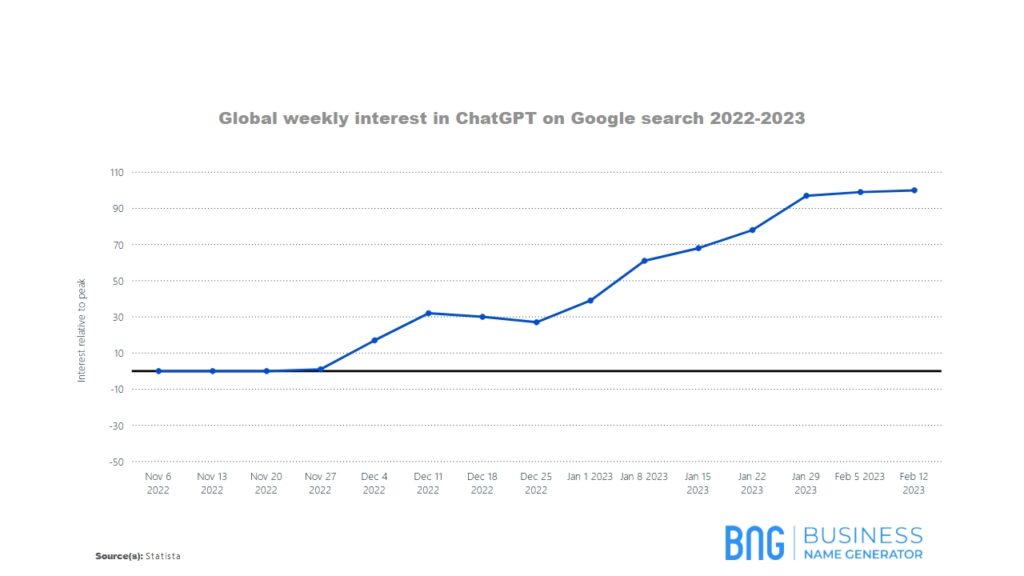
Despite the impressive numbers, there is still some kind of reluctance toward using ChatGPT. According to a recent survey, ChatGPT is yet to get people on board when it comes to using the software to generate text. The surveyors asked respondents to declare how often they got in contact with ChatGPT, and they received the following results:
- “I’ve used it myself to generate text”: 12%
- “I’ve seen text it generated but haven’t used it myself”: 38%
- “I’ve never used it or seen anyone else use it”: 40%
- “Not sure”: 9%
One of the main factors to success in any industry, AI included, is having quality branding. A business name can make or break your chances of succeeding. With an AI startup, you want a “techie” name that makes it clear you’ll use artificial intelligence. Use our AI business name generator to come up with a killer name and get your feet off the ground.
With our AI business name generator, you get 1,000+ name ideas based on your keywords. You can use filters to finetune results, and we’ll check domain availability for you automatically. All you need to do is add up to six keywords, and press enter. The generator is free to use.
ChatGPT Cost of Running
When you have an app that’s able to access over a trillion parameters and generate text from nothing, it takes quite an infrastructure to run the software successfully.
An analysis done by Tom Goldstein shows that if you have a 3-billion parameter model, you’ll need 6ms to generate a token on an A100 GPU. With GPT-3 having 175 billion parameters, you’ll need 350ms for a single word. Since ChatGPT is capable of printing out 15-20 words per second, that means the infrastructure uses at least an 8-GPU server (based on Microsoft Azure).
In layman’s terms, you need a huge server to support ChatGPT, and only a huge cloud service provider like Azure can do that. For instance, a single A100 card costs $3 an hour.
With the number of queries the app has to deal with, the model needs to generate a massive amount of words. Although we don’t have precise numbers from OpenAI, it’s safe to assume that ChatGPT costs $100,000 every single day. This equates to about $3 million per month.
With the company’s estimated revenue for 2022 being below $20 million, it’s highly likely OpenAI is actually losing money on ChatGPT and runs on a strong belief the trend will soon change, and drastically so.
ChatGPT User Metrics
As we’ve mentioned above, ChatGPT has the highest-growing user base. In January 2023, the monthly ChatGPT user count was around 100 million. In the first month of its availability, the app amassed 57 million users.
The launch of ChatGPT also brought a peak in the general interest in generative AI (AI that creates content, be it text, imagery, or anything else).
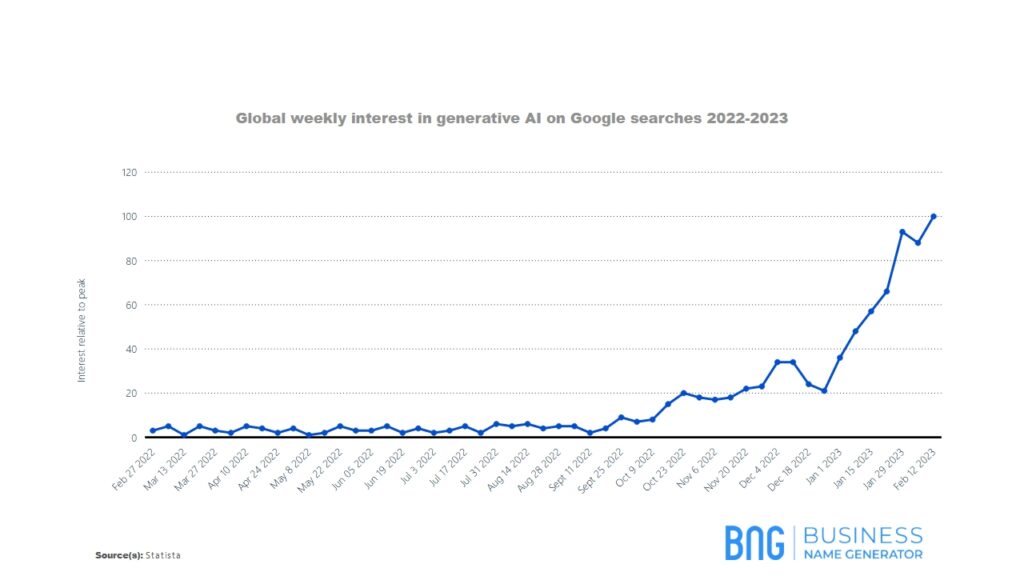
How does this reflect on ChatGPT? According to Similarweb, ChatGPT attracts 25 million users a day, resulting in 10 million queries being made.
ChatGPT Pricing
In February 2023, OpenAI launched ChatGPT Plus, a premium version of the app that costs $20 per month to use. Getting the Plus version brings several benefits to users, such as:
- Quicker response time
- Priority access to the platform during peak times
- Priority access to new features and improvements
You can still use the basic version for free. Despite the huge costs of running such complex software, OpenAI claims they will always have a free version available. In 1973, Richard Serra wisely noted that if something is free, it’s because you are the product.
OpenAI logs all interactions on ChatGPT and uses it to improve the model. The more people use it, the better it becomes at predicting what kind of responses users expect. This allows the app to provide more accurate responses and lead a human-like conversation.
ChatGPT Limitations
Despite being by far the most popular AI chatbot, ChatGPT is far from an ideal product, and it only gives us a glimpse into potential AI capabilities. The software has several limitations in its use and implementation, many of which OpenAI itself talked about.
One of the major limitations is the cost of running. It comes with demanding computational requirements, and any real-world application of the software is likely to be thwarted by the cost of running.
Another issue is that ChatGPT lacks access to the Internet. This means that it can’t open links or improve its knowledge base with data outside its training dataset. The cutoff year for the dataset is 2021, meaning that any data made available in 2022 and later is invisible to the chatbot.
Other limitations include the following:
- Nonsensical answers
- Plausible-sounding but inaccurate answers
- Excessive repetition
- Biased answers
- Input sensitivity (the answer may vary depending on user’s phrasing)
- Sometimes responds to harmful queries
- It can process a limited number of questions per hour
Common ChatGPT Errors: Explanations and Solutions
Let’s go over some of the most common errors that occur during the use of ChatGPT and explain what they mean:
| Error Message | What It Means | What to Do |
|---|---|---|
| ChatGPT internal server error | Server-side issues that occur when the software runs out of computing capacity. | The error shows that the server is getting overworked with too many users present. Check the status and come back later when it’s less crowded. |
| ChatGPT network error on long responses | The chatbot has a 60-second timeout. If it fails to come back with an answer, you’ll get a network error. | When it happens, you need to restart the chat. To avoid the error, instruct the chatbot to break up its answer into multiple shorter responses. |
| ChatGPT error code 1020 | The error occurs when the servers are overloaded, and they try to limit the number of users. | Use VPN to try and get a different access point. If the error persists, consider using a different browser. |
ChatGPT AI Alternatives — Competitor Analysis
As you’d expect, big tech companies weren’t going to sit idly and watch OpenAI scoop up all the attention. Some reports claim the launch of ChatGPT triggered alarm bells at Google. With the chatbot being able to directly provide answers to queries, users can now bypass the search engine and stop searching for answers by clicking on various links.
In February 2023, Google launched BARD, its own chatbot based on the company’s conversational language model LaMDA. The app is available for early access in the United States and the United Kingdom. Still, it’s obvious Google is behind OpenAI with its chatbot, and it will take some time to see if it can rival ChatGPT properly.
Microsoft also has Bing AI that assists during search queries, but it’s unclear what the future of it will be after the company invested heavily in OpenAI.
In terms of market share, nobody can rival ChatGPT as things stand now. That doesn’t mean there are no other chatbots on the market. Take a look at ChatGPT AI alternatives and what they bring to the table:
| Chatbot | Pros | Cons |
|---|---|---|
| Jasper Chat | Complex conversations Great for generating marketing copy | Expensive Older dataset |
| ChatSonic | Internet access Android app Different conversation personas | Only the first 25 answers are free |
| Character AI | Personality selection Image generator Creating your own character | Slow responses |
| Caktus AI | Dedicated to students Cites sources Educational features | No free trial |
| Perplexity AI | Cites sources | Sometimes copies directly from sources No chat memory |
| YouChat | Similar to ChatGPT Access to Internet Up-to-date information | Refuses to respond at times |
ChatGPT Market Size
The artificial intelligence market is on the rise, and one of its elements, the chatbot market, is no different. In 2016, the global chatbot market value was about $190 million. According to some projections, that number should be about $1.25 billion in 2025.
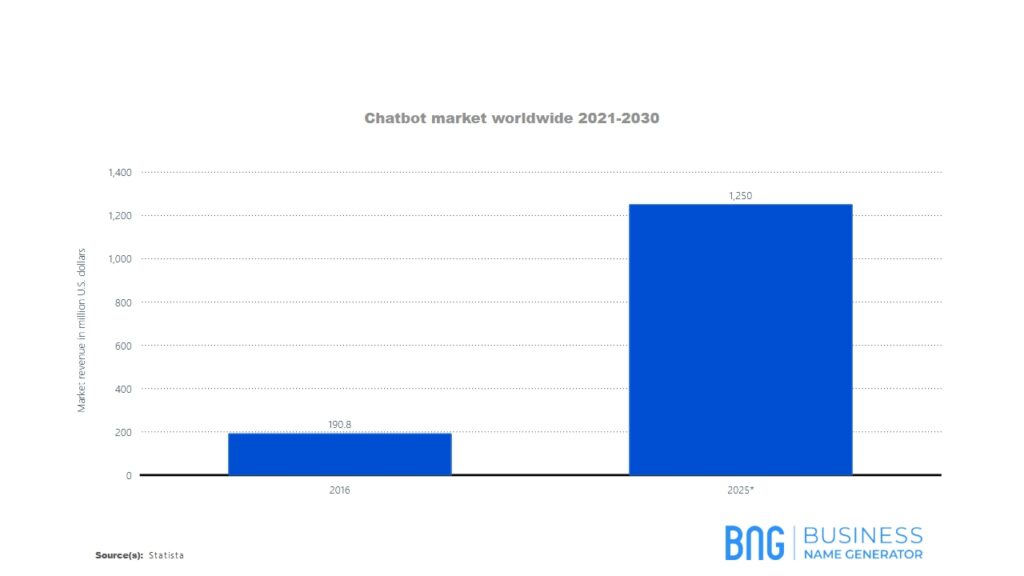
The rise of the chatbot market reflects the growth of the revenue generated by chatbots as well. In 2018, few could predict how rapidly the chatbot market would rise — the revenue it generated for the whole year amounted to $40.9 million worldwide.
With the rise of ChatGPT and its rivals, the numbers are growing steadily. Estimations show that the global chatbot revenue should be just under $455 million in 2027.
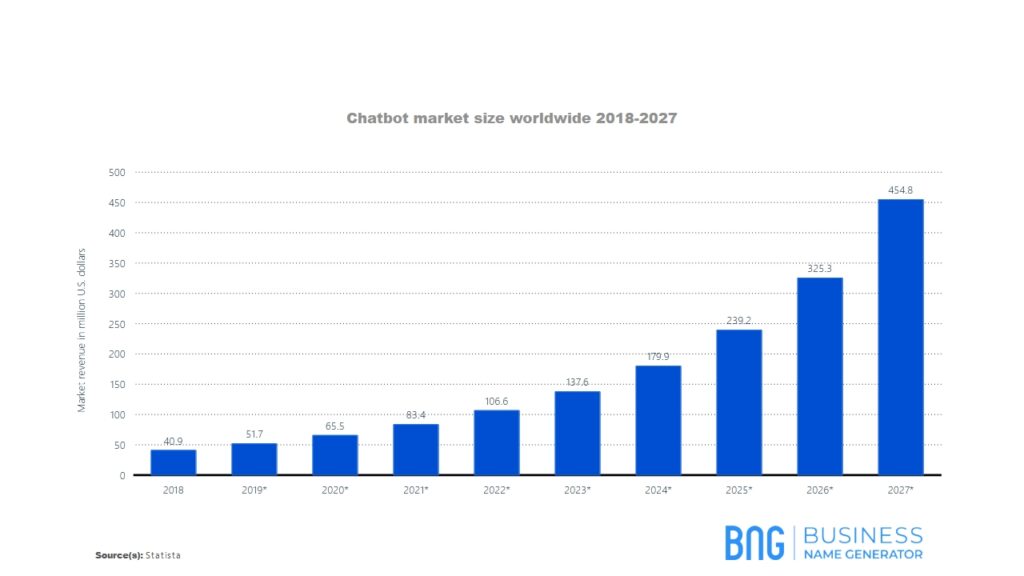
While it’s unclear what share ChatGPT will have in the global market size, the numbers don’t fully reflect how much money OpenAI will earn in total. According to Reuters, the company plans to have an annual revenue of $200 million in 2023. That number is expected to rise to a whopping $1 billion in 2024.
Using ChatGPT — How Your Business Can Benefit
As we’ve explained, using ChatGPT for real-world applications won’t happen soon due to hardware constraints. As a business, you’re unlikely to be able to replicate the infrastructure necessary for independent use of the app.
Still, that doesn’t mean you can’t use it to your benefit. Many use ChatGPT already for various functions. These include:
- Creating content and copy
- Writing code
- Compile research
- Translate text
- Increase customer engagement
- Generate simple explanations for complicated topics
- Find datasets
- Analyze the sentiment and tone of a text
If you want to enter the AI space, you can use ChatGPT API to build your own chatbot and add improvements that will make your software stand out. Many investors are seeking opportunities to enter the chatbot market, and you might provide the right solution.
Despite some cities being more AI-conscious than others, investment into AI is taking place on a global scale. Chatbot startups (not named OpenAI) have managed to attract millions of dollars in investment.
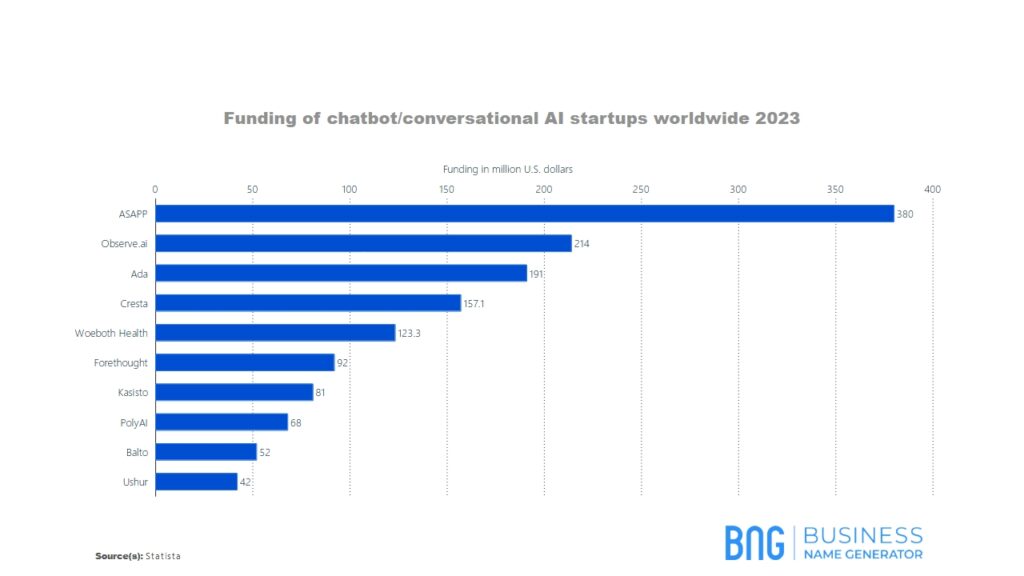
Aside from an AI model, you’ll also need a catchy business name to succeed. Try out our AI business name generator for free and get 1,000+ name ideas for your chatbot.
Conclusion
ChatGPT has taken the world by storm and has seen an astronomical rise in the few months it’s been available for. It’s a great ambassador for the use of AI in business and shows how much artificial intelligence can improve our lives and save time on manual tasks.
While it’s still in its early phase of development, the chatbot market shows promising signs it can develop and reach millions of dollars in revenue. ChatGPT can be a torchbearer for future chatbots that bring the same (or greater) complexity at more affordable costs.
With $1 billion of expected revenue in the next year, OpenAI shows that the future lies in AI, and there’s no reason why you shouldn’t take a piece of that artificial pie.